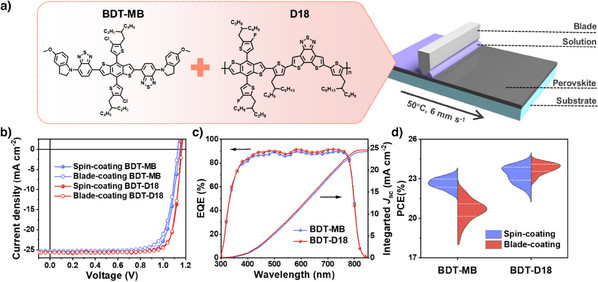Molecule-Cooperative Strategy for Dopant-Free Hole Transporting Layer toward Fully Printed High-Performance Perovskite Solar Cell Modules
Qinrong Cheng1, Hongxiang Li3(李鸿祥)*, Weijie Chen1, Yixin Cao1, Junyuan Ding1, Yue Yin1, Jiacheng Xu1, Haiyang Chen1, Jianlei Cao1, Yaowen Li1,2(李耀文)*
1Laboratory of Advanced Optoelectronic Materials, Suzhou Key Laboratory of Novel Semiconductor-optoelectronics Materials and Devices, State Key Laboratory of Bioinspired Interfacial Materials Science, College of Chemistry, Chemical Engineering and Materials Science, Soochow University, Suzhou 215123, China
2Jiangsu Key Laboratory of Advanced Negative Carbon Technologies, Soochow University, Suzhou 215123, China
3College of Polymer Science and Engineering, State Key Laboratory of Polymer Materials Engineering, Sichuan University, Chengdu, 610065, China
Angew. Chem. Int. Ed. 2025, 64, e202509459
Abstract: Enabling large-area deposition of dopant-free organic hole transport layers (HTLs) with high reproducibility and uniformity is crucial for fully printed n-i-p perovskite solar cell (pero-SC) modules. However, typical polymer hole transport materials (HTMs), with non-Newtonian fluid characteristics, show shear rate-dependent viscosity during the printing process, whereas blade-coated small-molecule HTLs often exhibit unfavorable assembly behavior and solute random distribution caused by molecular aggregation and low viscosity; these factors impose challenges on blade-coating of high-quality large-area HTL films. Here, we designed a dopant-free small molecule BDT-MB with high mobility and further proposed a molecular cooperative (MC) strategy by combining with polymer D18. The mechanism was clearly clarified that the pre-aggregated polymer D18 acted as a “seed crystal” to induce preferential face-on orientation of small molecule BDT-MB through intermolecular C─H···π interaction. This strategy not only suppresses the unfavorable assembly behavior of small molecular HTMs but also overcomes the solute random distribution by tuning the solution with high and constant viscosity. It facilitates printing large-area dopant-free HTLs with high uniformity and ordered fiber-like morphology. The resultant small-area pero-SCs (0.062 cm2) and large-area fully printed modules (15.64 cm2) both achieved record power conversion efficiencies (PCEs) of 24.46% (certified at 24.30%) and 21.04%.

Article information: https://doi.org/10.1002/anie.202509459